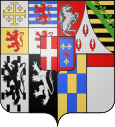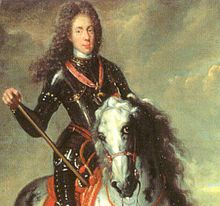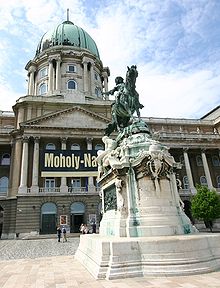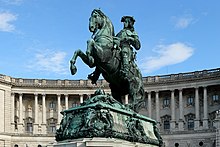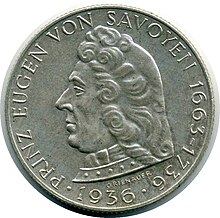Eugene of Savoy

Eugen Franz, Prince of Savoyen-Carignan ( French François-Eugène de Savoie-Carignan , Italian Eugenio di Savoia-Carignano ; born October 18, 1663 in Paris , † April 21, 1736 in Vienna ) - made famous under the name of Prinz Eugen - was one of the most important generals of the Habsburg Empire , whose position as a great power he significantly expanded. From 1697 he was Commander-in-Chief in the Great Turkish War . He served alongside the Duke of Marlborough during the War of the Spanish Succession(1701–1714) Commander in Chief of the anti-French coalition . After the resumption of the war against the Ottomans (1714-1718), he secured Austrian supremacy in south-eastern Europe. In addition, he was for a long time President of the Court War Council as well as active as a diplomat and held other high state offices. As a builder and art collector, he was one of the most important patrons of his time.
origin
| Since Eugene came from the Savoy-Carignan branch, he bore their coat of arms, among other things in the form shown here. There was also a variant that showed the coat of arms of the Spanish Habsburgs as the heraldic left half of the shield. Eugen's coat of arms differed from the coat of arms of the main line of Savoy by the heart shield, which heraldically shows the Soissons coat of arms (three golden lilies on blue with a red sloping bar) to the left of the coat of arms of Savoy (silver cross on red). |
Eugen belonged to the European nobility . His family had connections to the Spanish and Austrian Habsburgs as well as to the French Bourbons and the German houses of Wittelsbach and Baden-Baden . Eugen benefited from these cross-border family relationships especially at the beginning of his military career. When choosing his employers, he did not pay attention to the country in which he wanted to serve - no special attitude for the European nobility of the early modern period .
Because he hoped for a successful military career, he offered his services to the House of Austria , although he came from the House of Savoyen-Carignan, a branch in France of the Savoy ducal dynasty that ruled sovereignly in Italy . Eugen loyally represented the interests of his Austrian employer throughout his life, but was nevertheless proud of his Franco-Italian origins, as his signature shows: It consisted of the Italian Eugenio , the German von and the French Savoy or Savoye .
The House of Savoy-Carignan was founded by Eugene's grandfather Tommaso Francesco (1595-1656), the youngest son of the Savoy Duke Carlo Emanuele I (1562-1630) , who was appointed by his father as the first prince of Carignan in 1620 and 1625 had married the French princess Marie Marguerite de Bourbon (1606-1692). This belonged to the House of Condé , a branch of the ruling French royal house of the Bourbons, and after the death of her brother in 1641 brought the French county of Soissons into the family. With their inheritance the title of Count of Soissons was connected, which 1656 went to Eugen's father Eugène-Maurice (1635-1673); in addition, there was the highly respected title of prince of the blood , held by members of secondary lines of the royal family, which was highly regarded at the Versailles court .
His father gained additional importance a year later through his marriage to Olympia Mancini (1639–1708), the niece of the powerful Cardinal Mazarin (1602–1661). In addition to Eugene, the marriage produced four sons:
- Louis Thomas (1657–1702), Earl of Soissons
- Philippe (1659–1693), Dept.
- Louis-Jules (1660-1683), Chevalier de Savoie
- Emanuel-Philibert (1662–1676), Count of Dreux
They also had three daughters:
- Marie-Jeanne (1665–1705), Mademoiselle de Soissons
- Louise-Philiberte (1667–1726), Mademoiselle de Carignan
- Françoise (1668-1671).
Eugen's father Eugène-Maurice had received the French title of count from his mother, which he bequeathed to his eldest son Louis-Thomas. His older brother Emmanuel Philibert (1628–1709) took over the title of Prince of Carignan after the death of his father. The kings of Sardinia-Piedmont and the kings of Italy descend from him.
Eugene himself was related to leading heads of European politics, such as Duke Viktor Amadeus II of Savoy, who was briefly King of Sicily and then of Sardinia , with Maximilian II. , The Elector of Bavaria, and with Ludwig Wilhelm , the Margrave of Baden-Baden, which was also called "Türkenlouis" because of its military successes in the Turkish war . Eugene was also related to Louis II. De Bourbon, prince de Condé , and Louis II. Joseph de Bourbon, duc de Vendôme .
Many of his family members embarked on military careers in various European armies. Eugen's grandfather, Tommaso Francesco, had served in Spain and France, and Eugen's father, Eugène-Maurice, later served in the army. Eugen could not follow this career path as the family had since fallen out of favor. Like his brothers Louis-Jules and Emanuel-Philibert, he therefore had to seek his luck outside of France.
Life
Youth in Paris (1663–1683)
Eugen was born in Paris in the Hôtel Soissons . He grew up there too. The father died when he was ten years old. The mother was at times a favorite of King Louis XIV before an estrangement occurred. She had hardly brought up her seven children because she was fully involved in court life and the intrigues there. Embroiled in scandals, she is even said to have poisoned her husband, she had to flee France in 1680. The children remained under the care of their mother-in-law. Liselotte von der Pfalz remembered Eugen as a "dirty very debauched [dissolute living]" boy who would probably get nowhere.
Louis XIV and the Duke of Savoy chose him for a spiritual career. At the age of fifteen he already owned two abbeys , which is why he was called "the little Abbé" at court. Rumors circulated and Liselotte noted “Mad. Lansiene and Mad. Simone "be called the Äbtchen, anyway," he did not incommodiert with ladies, a few beautiful pages would better be kind! "But he bowed to the military career to and therefore asked for the command of a regiment which it because of its Status was due. The king allegedly refused this with reference to his slender figure. According to other sources, however, this rejection was based on distrust of Eugen's once powerful mother.
Rise in the service of the Habsburgs (1683–1697)
Eugene did not submit to it. In July 1683 he learned of the death of his brother, Colonel Ludwig Julius of Savoy . He was seriously wounded in a battle against 40,000 Crimean Tatars at Petronell in Austria and died days later from his injuries. Eugene secretly left Paris. The prince hoped to keep his brother's imperial dragoon regiment and went to Passau to see Emperor Leopold I.

In Austria he received an officer's license, but the regiment rode under Donat Johann Graf Heissler von Heitersheim attacks against the Ottoman supplies near Vienna , which was just besieged by the Turks . As a young lieutenant colonel , Eugen then moved to Vienna with the relief army and fought at the side of his cousin Ludwig Wilhelm von Baden in the Battle of Kahlenberg . Apparently he proved himself and enjoyed the protection of the Baden, the Spaniard and the favor of the Bavarian Elector Max Emanuel .
On December 14, 1683, he was therefore given as a colonel his own dragoon regiment with a strength of ten companies . In the following years he still considered switching to the services of Savoy or Spain. When he traveled to Madrid in 1685, he was even raised to the rank of Spanish grandee and received the Order of the Golden Fleece. His mother's attempts to marry him off to Spanish women failed. Ultimately, he remained in the Austrian-Habsburg service.
Eugene took part in the battles of the first phase of the great Turkish war. On October 16, 1685 he was general field sergeant , which corresponds to a major general . On January 31, 1688 he was Lieutenant Field Marshal , 1690 General of the Cavalry and on May 25, 1693 Field Marshal . He was wounded during the siege of Belgrade in 1688 and in front of Mainz in 1689. Without really showing off, he had commanded a larger unit since 1690. When Duke Viktor Amadeus II of Savoy was defeated by the French at the Battle of Staffarda , Eugene covered the Savoy's retreat. In 1693 he took part in the Battle of Marsaglia . In 1696 he commanded the imperial army in northern Italy and left the country under the Treaty of Vigevano .
Turkish War and the following years (1697–1700)
After all, important circles became aware of him, and the President of the Court War Council, Ernst Rüdiger von Starhemberg, recommended him in 1697 for the supreme command in the still ongoing Great Turkish War . In 1697 he was first deputy commander-in-chief in Hungary. From July 5, 1697, Eugene was in command of the Habsburg counter-attack in Hungary as commander-in-chief. He reorganized the troops and restored their reduced combat strength. His reputation as a general was founded on the decisive victory in the battle of Zenta (in Vojvodina ) on September 11, 1697, where he was able to destroy the main power of the Ottoman army at a river crossing. Immediately afterwards he took Sarajevo , the city being almost completely destroyed by fire. The immediate consequence was the Treaty of Karlowitz in 1699, in which Austria acquired Turkish-Hungarians , Transylvania and Slavonia and thus consolidated its status as a great power .
At the beginning of 1700 he was appointed a member of the secret council by Leopold I and has since been one of the most important men in the empire. He also demonstrated this in public with magnificent baroque buildings.
War of the Spanish Succession (1701-1714)
The coalition on the offensive
Politically, Prince Eugene hardly played a role before the outbreak of the War of the Spanish Succession . He had no direct influence on the decisions of the emperor that ultimately led to the war. It is possible, however, that his insistence on the conclusion of the alliance between Austria and Great Britain and the Netherlands contributed to starting the conflict with an attack in northern Italy. In 1700, Eugene was appointed Commander-in-Chief in Italy. Organizationally, the project was poorly prepared. Eugen managed to lead his troops across the Alps. He defeated the initially taken by surprise French troops in 1701 in the battles at Carpi and Chiari . The coup of Cremona and the battle of Luzzara followed in 1702 . In the course of the dispute it became clear that the authorities in Vienna were unable to provide sufficient supplies. This prevented complete victory in this theater of war. At the same time he saw Austria as acutely threatened by the alliance between France and Bavaria and the rebellious Hungarians .
All this prompted Eugene to go to Vienna at the end of 1702 to press for changes in the central positions for the military. Initially, this had little success. On June 27, 1703, he was appointed President of the Court War Council in Vienna and on May 2, 1708, Lieutenant General , in Austria at that time the highest military title as the Emperor's Deputy in the Army High Command. He now combined the post of minister and general. Initially, he took care of an initially improvised reorganization of the military and, when it came to the question of financing, did not take into account the traditional rights of the estates. The diplomat Johann Wenzel Wratislaw von Mitrowitz , who became his foreign policy advisor and friend, played an important role in the political flanking of the war . This was largely responsible for the formation of the Hague coalition of Great Britain, the Netherlands and Austria.
From 1704 he commanded the troops in the west. In the further course of the War of the Spanish Succession he won the brilliant victory at Höchstädt (1704) together with the Duke of Marlborough , the commander of the allied British troops . Although the Duke of Marlborough played an important role militarily, the actual strategic planning of the war lay with Eugene of Savoy. But he also took on the difficult tasks during operations and battles.
In Austria itself, however, Eugene met resistance. As leader of the “war party” alongside the later Emperor Joseph , he largely pushed Emperor Leopold into the background in his last years. The problems in the capital did not end until Joseph succeeded his father. The new emperor gave Eugen and Johann Wenzel Wratislaw von Mitrowitz largely a free hand.
Eugene defeated the French troops in the Battle of Turin in 1706 on the Italian theater of war. This broke the influence of Louis XIV in Italy. On February 21, 1707, Eugen was elected Reichsfeldmarschall by the Reichstag . From 1707 to 1715 he was also governor general of Milan . At this time he had the painter Jan van Huchtenburgh in service. Under pressure from the naval powers, he undertook an expedition to Toulon in 1707 . After an unsuccessful siege of the city, he led his troops back to northern Italy.
Together with the Duke of Marlborough he won the Battle of Oudenaarde in 1708 . With the city of Lille , the anti-French coalition fell into a key strategic position. France seemed defeated and negotiations for a preliminary peace broke out in The Hague. Eugen represented the imperial side. The Allies demanded from Louis XIV not only the renunciation of the Kingdom of Spain claimed by the Bourbons, but also the return of the city of Strasbourg, which had previously been lost to France . These excessive demands, for which Eugen was not responsible, prevented an end to the war. Eugen and the Duke of Marlborough won again in 1709 in the Battle of Malplaquet . Nevertheless, this could not end the war, which continued with varying degrees of success.
Defensive and peace treaty
After the death of the emperor in 1711 and the seizure of power by his brother Charles VI. the war coalition broke up. The background was that Charles also claimed the Spanish throne and the previous allies saw in this the danger of an overpowering Austria.
Eugen himself traveled in 1712 on behalf of the emperor to the British Queen Anne , where he was supposed to get Britain to remain in the alliance against France. Although he received an audience, his mission was unsuccessful. It also played a role that the Duke of Marlborough had been overthrown. Eugen's warfare was thus on the defensive. A Dutch army led by him was defeated by the French in the Battle of Denain , and the Dutch also withdrew from the war. Charles VI's attempt, after the dissolution of the Great Alliance in the Peace of Utrecht in 1713, to continue the struggle based only on the forces of the Empire and Austria, proved unsuccessful. In early 1714, Eugene negotiated with the French Marshal Claude-Louis-Hector de Villars to end the fighting. The division of the Spanish inheritance was confirmed in the Peace of Rastatt : While Spain and the colonies fell to the French pretender to the throne , the Spanish Netherlands and the Italian possessions went to Austria. A few months later, Eugen appeared as a celebrated diplomat and plenipotentiary at the peace congress in Baden , where the final peace treaty was converted into a legally binding form.
Venetian-Austrian Turkish War (1714-1718)

At his urging, the war against the Turks was resumed. He fought in the Venetian-Austrian Turkish War from 1716 to 1718 . The main aim was to secure the Habsburg power in south-eastern Europe. Eugene won the victory in Peterwardein and with his troops conquered the Belgrade fortress on August 17, 1717 by attacking not from the land as expected, but from the water using a pontoon bridge . This victory is immortalized in the song of Prince Eugene (also known as Prince Eugene, the noble knight ). The subsequent Peace of Passarowitz (1718) enlarged Austria to include northern Serbia , Banat and western Wallachia . Eugene was at the height of his reputation, and Frederick the Great later referred to him as the real emperor.
Last years in Vienna (1718–1736)
In fact, he now combined his office as the President of the Court War Council with that of the Chairman of the Secret Conference . He was also officially governor in the Austrian Netherlands from 1716 to 1724 . However, he was by no means overpowering. Honored many times by the emperor, the personal relationship remained rather distant. He survived numerous intrigues at court, but hardly any major political impulses came from him. In particular, he failed to adapt the military organization to the changing conditions. In foreign policy, too, he could no longer work without the interference of other forces. If he had initially sought rapprochement with France, he later sought the alliance with Great Britain and the Netherlands again.
In the War of the Polish Succession , Prince Eugene commanded the imperial troops on the Rhine . His health was in very poor health at the time, and his strategic skills were blocked by his fearfulness. So he did not dare to prevent the French from taking Philippsburg before his eyes . In the meantime, Johann Christoph Bartenstein was working in the background to replace Eugen. So the emperor made peace without consulting Prince Eugene.
Death and honorary funeral 1736
When he died of pneumonia on April 21, 1736, his fortune fell to his niece Anna Viktoria von Savoyen (1683–1763) because he had not made a will. His property consisted of expensive castles, lands, cash and bank assets as well as art collections and a zoo with animals from all over the world valued at 1.8 million guilders. His niece gradually sold most of the property or had it auctioned. She transferred her own great fortune to her later, much younger husband, Joseph Friedrich von Sachsen-Hildburghausen . The castrum doloris , which was used at the funeral ceremonies, is only partially preserved because it was made from non-permanent materials. These parts of the mourning decoration are now in the Army History Museum in Vienna.
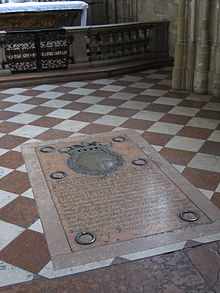
Prince Eugene is resting in the chapel in St. Stephen's Cathedral in Vienna , which is named after him, but is also called Kreuz- or Tirnakapelle . The marble tomb in the left side wall had the wife of his nephew, Maria Theresia Anna Felicitas Duchess of Savoyen-Carignano , née Princess Liechtenstein , built in 1752 . The performing artists were Joseph Wurschbauer as a sculptor and goldsmith and as a stonemason Gabriel Steinböck .
Inscription on the tomb in St. Stephen's Cathedral in Vienna
|
.Alpha. Χ ohms |
“Christ's beginning and end. |
His heart was in the grave church of the House of Savoy, the Basilica di Superga in Turin , buried separately .
Hugo von Hofmannsthal wrote: Eugen's last days and the lion in the Belvedere ... the King of France, whom he had defeated so often, adored an African lion for him ... finally three days came when the lion no longer saw his master, he refused to eat and paced restlessly up and down the cage ... around three o'clock in the morning he let out such a roar that the keeper ran out to the menagerie to see. Then he saw lights in all the rooms of the palace, at the same time he heard the death of the valley in the chapel and so he knew that his master, the great Prince Eugene, had died at that very hour .
Private citizen
There were already poems in circulation about Prince Eugene during his lifetime ( Mars without Venus ) that said he was homosexual . The very short prince had never married, and nothing was known about affairs with women. To this day, he is regularly included on lists of famous homosexuals, although there is no solid evidence of this.
Builder and patron




He had several castles designed by his favorite architect Johann Lukas von Hildebrandt , such as Ráckeve Castle in Hungary from 1701–02 . In 1694 he bought a house in Vienna's Himmelpfortgasse and had it rebuilt by 1697. In 1703 the city palace in Vienna was built according to plans by Johann Bernhard Fischer von Erlach and expanded from 1708 to 1709, and in 1726 Hof Palace in Marchfeld was rebuilt. Hildebrandt's main work, Belvedere Palace , was also built for the prince in two stages (1714ff. And 1721ff.), Today's Upper Belvedere. There is still some uncertainty as to how he was able to finance this collecting and building activity. After his death, the imperial family acquired his castles, and the Belvedere temporarily became a kind of second residence.
Even with the intellectual currents of his time, he was very familiar: the Monadology of Leibniz was created at his suggestion. He was also in contact with Montesquieu and Voltaire .
His activity as a collector and art patron is of lasting importance. His huge collection of books, the Eugeniana , now fills the state hall of the Austrian National Library .
Reception and naming

The prince was already very popular during his lifetime, especially among his soldiers and servants. He was social towards them, the gardeners of his castles, for example, continued to be employed in winter.
Eugen is immortalized in numerous busts and equestrian statues. The best known is the Prince Eugene Equestrian Monument, unveiled on October 18, 1865, on Heldenplatz in Vienna , the work of the sculptor Anton Dominik Fernkorn and his pupil Franz Pönninger .
The statue Apotheosis of Prince Eugene by Balthasar Permoser stands today in the Lower Belvedere . It is said that the prince did not like her, that she was too overloaded for him.
By the imperial resolution of Franz Joseph I. from 28 February 1863 Eugen was of Savoy in the list of "most famous, to the everlasting emulation worthy warlords and generals of Austria" added to their honor and memory of a life-size statue in the Feldherrenhalle of time The newly established Imperial and Royal Court Weapons Museum (today: Heeresgeschichtliches Museum Wien ) was built. The statue was created in 1869 from Carrara marble by the sculptor Carl Kundmann and was dedicated to its former owner by the Dragoon Regiment No. 13 .
Numerous other memorabilia are on display in the Army History Museum, including those from Prince Eugene's personal belongings. You can see two of his personal clothes ( Koller and Kamisol ), his cuirass , command staff and sword , the standard of his dragoon regiment "Eugene Prince of Savoy" and the parts of the funeral decorations that were kept after his death in 1736 . Objects that Prince Eugene captured during his numerous campaigns are also exhibited, such as the seal of the Turkish Sultan Mustafa II from the Battle of Zenta , a Turkish state tent captured near Peterwardein in 1716, as well as the ten-pound mortar from Belgrade , which carried a A single shot in a Turkish powder magazine destroyed an entire district of Belgrade .
Ships named after him served in the Austrian Navy , the British Royal Navy , the Italian Marina Militare , the United States Navy and the German Navy .
- HMS Prince Eugene (1915) - Lord Clive-class monitor from 1915
- SMS Prinz Eugen - K&K central battery ironclad from 1878
- SMS Prinz Eugen - K&K battleship of the Tegetthoff class from 1912
- Prinz Eugen - German heavy cruiser from 1938, which was taken over as spoils of war by the United States Navy as USS Prinz Eugen (IX-300) in 1945 and sunk in the course of the nuclear tests at Bikini Atoll
- RN Eugenio di Savoia - Italian cruiser from 1935
The military road over the Vršičpass , built for supplies to the Isonzo battles around 1915, was named Prinz-Eugen-Straße by Austria-Hungary.
Consisting mainly in the northern Serbian Banat ethnic Germans erected 7th SS Volunteer Mountain Division "Prinz Eugen" was named after the commander, as he the settlement made possible by the expulsion of the Ottomans from the Balkans Folk German. As the later division commander Otto Kumm pointed out, this was a deliberate link to the centuries-old tradition of the Grenzer regiments.
The Association of German Pioneers (BDPi) awards a Prinz Eugen Prize for the best course in construction engineering courses at the Army School for Construction Technology.
Among other things, there are or were Prinz-Eugen barracks in Munich .
There are also numerous street names, such as Prinz-Eugen-Straße in Vienna (which runs on the west side of Belvedere Palace). A street in Berlin-Wedding also bears his name due to his participation in the War of the Spanish Succession.
A TEE (later EC and then ICE) train between northern Germany and Vienna was called Prinz Eugen from 1971 to 2004 .
The plant genera Eugenia L. and Eugeniopsis O.Berg from the myrtle family (Myrtaceae) are named after him.
Prince Eugen's popularity was also reflected in the song Prinz Eugen, the noble knight .
literature
- Alfred Ritter von Arneth : Prince Eugene of Savoy. According to the handwritten sources in the imperial archives. 3 volumes. Typographical-literary-artistic establishment, Vienna 1858.
- Irma Hift : Prinz Eugen - From his letters and conversations , Leipzig 1917 ( Austrian Library 17)
- Max Braubach : Prince Eugene of Savoy. A biography. 5 volumes. Oldenbourg, Vienna 1963–65.
- Max Braubach: Eugene Prince of Savoy. In: New German Biography (NDB). Volume 4, Duncker & Humblot, Berlin 1959, ISBN 3-428-00185-0 , pp. 673-678 ( digitized version ).
- Peter Broucek , Erich Hillbrand , Fritz Vesely: Prinz Eugen. Campaigns and armies . Deuticke, Vienna 1986, ISBN 3-7005-4561-4 .
- Hanne Egghardt : Prince Eugene. The philosopher in war armor. Kremayr & Scheriau, Vienna 2007, ISBN 978-3-218-00770-2 .
- Hanne Egghardt: In the footsteps of Prince Eugen. Baroque splendor in and around Vienna. Kremayr & Scheriau, Vienna 2008, ISBN 978-3-218-00782-5 .
- Friedrich Jakob Heller : Military correspondence of Prince Eugene of Savoy. From original Austrian sources. (Year 1694 to 1702.) , Vienna 1848 Digitized at the Bavarian State Library
- Friedrich Jakob Heller: Military correspondence of Prince Eugene of Savoy. From original Austrian sources. (Year 1703 to the end of August 1705.) , Vienna 1848 Digitized at the Bayerischer Staatsbibliothek
- Agnes Husslein-Arco , Marie-Louise von Plessen (ed.): Prinz Eugen. General and philosopher. Hirmer Verlag, Vienna 2010, ISBN 978-3-7774-2521-4 .
- Karl Gutkas : Prince Eugene and Baroque Austria. Exhibition of the Republic of Austria and the Province of Lower Austria; Marchfeldschlösser Schlosshof and Niederweiden, April 22 to October 26, 1986. Niederösterreichisches Landesmuseum, Vienna 1986, ISBN 3-900464-37-6 .
- Franz Herre : Prince Eugene. Europe's secret ruler. Deutsche Verlagsanstalt, Stuttgart 1997, ISBN 3-421-05085-6 .
- Gottfried Mraz : Prince Eugene. A life in pictures and documents. Süddeutscher Verlag, Munich 1985, ISBN 3-7991-6224-6 .
- Georg Piltz : Prince Eugene of Savoy. Biography. Verlag Neues Leben, Berlin 1991, ISBN 3-355-01192-4 .
- Peter Stephan : The Upper Belvedere in Vienna. Iconography and Architectural Concept. Prince Eugene's castle as an expression of his self-image. Böhlau-Verlag, Vienna 2010, ISBN 978-3-205-77785-4 .
- Harald Waitzbauer (Red.): Prinz Eugen - Winter Palace. Hidden baroque jewel. Federal Ministry of Finance, Vienna 1998.
Movies
- Prinz Eugen and the Ottoman Empire. Two-part docu-drama , 110 min. In total, director: Heinz Leger, F / A 2014. A one-part version shortened to 88 min. Was broadcast under the title Prinz Eugen und die Türken - Kampf um Europa . (Topic: Enlargement of the Habsburg Empire through the campaigns of Eugene of Savoy. The way to Prince Eugene's own wealth.)
Web links
- Documentation Prinz Eugen - war entrepreneur, builder and patron ( BR-alpha / ORF ) from November 2013.
- Alfred Ritter von Arneth: Eugen (Prince of Savoy) . In: Allgemeine Deutsche Biographie (ADB). Volume 6, Duncker & Humblot, Leipzig 1877, pp. 406-421.
- Literature by and about Eugene of Savoy in the catalog of the German National Library
- Works by and about Eugen von Savoyen in the German Digital Library
- Entry on Eugene of Savoy in the Austria Forum (in the AEIOU Austria Lexicon )
- Entry on Eugene of Savoy in the database of the state's memory of the history of Lower Austria ( Museum Niederösterreich )
- Tobias Mayer: 08/16/1717 - Prince Eugene defeated the Turks WDR ZeitZeichen (podcast).
Individual evidence
- ^ Karl Gutkas : Prinz Eugen and the baroque Austria , Vienna 1986, p. 1.
- ↑ The specialist literature on the coat of arms of Prince Eugene has so far been limited. It is only dealt with by Franz Gall: Austrian Heraldry. Handbuch der Wappenwissenschaft , Vienna 1992, p. 369/70 and by Andreas Cornaro: Das Gesamtwappen des Prinzen Eugen in: Festschrift for the ten-year existence of the equestrian order Prinz Eugen , Vienna 1983. Karl Gutkas refers to both articles in Prinz Eugen and baroque Austria , Vienna 1986, p. 88. Cornaro and Gutkas assumed that the Spanish coat of arms was added to the coat of arms of Savoy after the Peace of Utrecht . In Korbinian Erdmann: The coat of arms of Prince Eugene of Savoy , Univ., Bachelor thesis, Passau 2011, pp. 41–45, this is refuted. According to the author, the Spanish half of the shield can be traced earlier, for example in a picture of Eugen's father Eugen Moritz von Savoyen-Carignan, and it seems to have been included in the Savoy coat of arms as early as 1585 after the marriage of Karl Emanuel I of Savoy to Katharina Michaela of Spain . According to Erdmann, p. 4/5, both versions of the coat of arms were used in parallel.
- ^ Karl Gutkas: Prinz Eugen und das Barocke Österreich , Vienna 1986, p. 87. See also Andreas Cornaro: Das Gesamtwappen des Prinzen Eugen in: Festschrift for the ten-year existence of the equestrian order Prinz Eugen , Vienna 1983, pp. 8-19 as well as Korbinian Erdmann: The coat of arms of Prince Eugene of Savoy , Univ., Bachelor thesis, Passau 2011.
- ^ Karl Gutkas: Prinz Eugen and the baroque Austria , Vienna 1986, p. 6.
- ^ A b Franz Herre: Prinz Eugen: Europe's secret ruler , Stuttgart 1997, p. 10.
- ^ Alfred Ritter von Arneth: Prinz Eugen von Savoyen , Vol. 1, Vienna 1864, p. 1.
- ^ Alfred Ritter von Arneth: Prinz Eugen von Savoyen , Vol. 1, Vienna 1864, pp. 3, 10, 125/6.
- ↑ Franz Herre: Prinz Eugen: Europe's secret ruler , Stuttgart 1997, p. 11.
- ↑ On Tommaso Francesco see: Karl Gutkas: Prinz Eugen und das Barocke Österreich , Vienna 1986, p. 122, on Eugène-Maurice see: ibid. P. 119.
- ^ Alfred Ritter von Arneth: Prinz Eugen von Savoyen , Vol. 1, Vienna 1864, p. 10.
- ↑ Max Braubach: Prince Eugene of Savoy. In: Hermann Heimpel et al. (Ed.): The great Germans. Volume 2, Gütersloh 1978, p. 22.
- ^ Rolf Hellmut Foerster : The world of the baroque. Great cultural epochs in texts, images and testimonies. Rheingauer Verlagsgesellschaft, new edition 1981, ISBN 3881020519 , p. 234.
- ^ Wolfgang Oppenheimer: Prince Eugene of Savoy. General, statesman and patron 1663–1736. Callwey, Munich 1979, ISBN 3-7667-0481-8 , p. 35.
- ↑ Patent for Prince Eugene of Savoy as colonel over a regiment of Dragoons, dated Linz, December 14, 1683, today in the Austrian State Archives / War Archives , quoted in: Heeresgeschichtliches Museum (Ed.): Prinz Eugen von Savoyen 1663–1736 . Exhibition on the occasion of his 300th birthday October 9 to December 31, 1963, Vienna 1963, p. 17 f.
- ^ RR Heinrich: Leopold I. In: Biographisches Lexikon zur Geschichte Südosteuropas Vol. 3, L - P. Munich, 1979 p. 24
- ^ Alfred Arneth: Prince Eugene of Savoy. Vol. 1 1663–1707 Vienna, 1858 pp. 422–435
- ↑ The Diary of the Peace of Baden 1714 by Caspar Joseph Dorer. With introduction and commentary edited by Barbara Schmid. (= Contributions to Aargau history. 18). Baden: Hier und Jetzt, 2014, ISBN 978-3-03919-327-1 .
- ↑ Max Braubach: Prince Eugene of Savoy. In: Hermann Heimpel et al. (Ed.): The great Germans. Volume 2, Gütersloh 1978, p. 27.
- ↑ Manfried Rauchsteiner : The Bahrtuch des Prince Eugene , in: Viribus Unitis. Annual report 2003 of the Heeresgeschichtliches Museum , Vienna 2004, pp. 7–22
- ↑ Gianluigi de Freddy: Descrizione della città, sobborghi, e vicinanze di Vienna , Volume 1, Vienna 1800, p 99-100
- ↑ This meant the funeral ceremonies, for which a "funeral scaffold" rich in figures was built and the whole cathedral was lined with black and decorated with coats of arms and memorial inscriptions ( picture and description , bestattungsmuseum.at)
- ^ According to The Last Years of Prince Eugen von Reinhold Schneider in Herrscher und Heilige , published in 1904 by J. Hegner in Cologne & Olten
- ↑ Prinz Eugen the noble knight, his life in pictures. Publishing house Seidel and Son in Vienna 1913
- ↑ Bernd-Ulrich Hergemöller , Man for Man , page 210
- ↑ Magnus Hirschfeld , The Homosexuality of Man and Woman, 1914/1984, page 661
- ^ Albert Moll , Famous Homosexuals, Wiesbaden, 1910, p. 36
- ↑ Homepage of the Austrian Commission for UNESCO, heritage of documents: Bibliotheca Eugeniana , as of August 31, 2020
- ↑ Alphons Lhotsky : The building history of the museums and the new castle . Das Kaiserforum, S 66/67, Verlag Ferdinand Berger, Vienna 1941.
- ^ Johann Christoph Allmayer-Beck : The Army History Museum Vienna. The museum and its representative rooms . Kiesel Verlag, Salzburg 1981, ISBN 3-7023-0113-5 , p. 33
- ↑ on the cuirass a total of 7 spherical marks can be seen, see Heeresgeschichtliches Museum (Ed.): Prinz Eugen von Savoyen 1663–1736. Exhibition on the occasion of his 300th birthday from October 9 to December 31, 1963, Vienna 1963, p. 241
- ^ Johann Christoph Allmayer-Beck : The Army History Museum Vienna. Hall I - From the beginnings of the standing army to the end of the 17th century, Salzburg 1982 p. 31 f.
- ↑ Manfried Rauchsteiner , Manfred Litscher (Ed.): The Army History Museum in Vienna. Graz / Vienna 2000 pp. 10–15.
- ↑ Lotte Burkhardt: Directory of eponymic plant names - extended edition. Part I and II. Botanic Garden and Botanical Museum Berlin , Freie Universität Berlin , Berlin 2018, ISBN 978-3-946292-26-5 doi: 10.3372 / epolist2018 .
| predecessor | government office | successor |
|---|---|---|
| occupied by the British; Striving for independence d. Dutch |
Governor of the Habsburg Netherlands 1716–1724 |
Maria Elisabeth of Austria |
| Heinrich Franz Count of Mansfeld |
President of the Court War Council 1703–1736 |
Lothar Joseph Count Königsegg |
| personal data | |
|---|---|
| SURNAME | Savoy, Eugene of |
| ALTERNATIVE NAMES | Savoyen-Carignan, Eugen Franz von; Prince Eugene, the noble knight |
| BRIEF DESCRIPTION | Austrian general and patron of the arts |
| BIRTH DATE | October 18, 1663 |
| PLACE OF BIRTH | Paris |
| DATE OF DEATH | April 21, 1736 |
| PLACE OF DEATH | Vienna |
